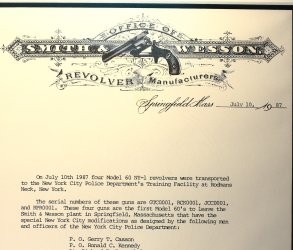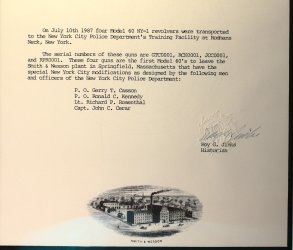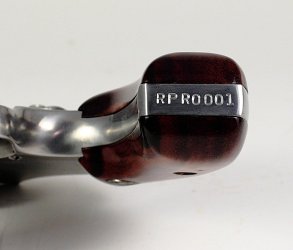I once saw at a gun show a Model 60 with a Model 38 hammer. Low snag but still cockable, easier than the Bodyguard. Claimed to be NYPD policewoman configuration.
Served as a sgt and lt at the NYPD Firearms and Tactics Unit. I was one of several officers who specified the model 60 NY-1 design (I specified stainless steel construction and a full width front sight; i.e, same width as the model 10 heavy barrel model). There was never an issued Model 60 with 38 hammer. "Police-womans" handguns went away sometime in the 1970s.
Mine is serial #RPR0001 (my initials).


Here's the whole story behind the development of that revolver and stainless revolvers at the NYPD specifically:
The Story of How the NYPD Switched to Stainless Steel Handguns as well as Why All S&W Two-Inch Barrel J-Frame Revolvers Now Have Full Width Front and Rear Sights
I served in the NYPD from October 24, 1969 to the end of April 1990 (from January 1990 until April 1990 I was on various leaves officers received upon retirement), retiring as a lieutenant, and become chief of police in Wellfleet MA (January 15, 1990~October 1, 2010). While in the NYPD one of my commands, serving as a sergeant and lieutenant, was in the Firearms & Tactics Section (FTS). I served under Commanding Officers Frank McGee, Tom McTernan and John Cerar, in that order.
All handguns used by the NYPD when I was with the FTS were of blued (ferrous) metal. From memory, my first stint with the unit started around 1981. My assignments were:
- Conduct the NYPD Police Firearms Instructors School
- Run the Heavy Weapons Training Unit
- Oversee Research and Testing
By 1981 it was clear to everyone in the police world that blued handguns (made of ferrous metals), which had a propensity to rust if not properly maintained, should have been replaced with stainless steel model revolvers some years earlier. The first stainless steel handgun which came out was in 1965, the S&W model 60. By the 1970s it was clear that this was the preferred material for service use handguns.
Yet, the NYPD stuck with their blued metal sidearms. Why?
On April 3, 1972, Detective William Capers, while on duty and attempting to arrest a robbery suspect, was killed by "friendly fire." The Detective was carrying a nickel-plated revolver at the time of his unfortunate death.
At the Grand Jury the officer who fired the fatal shot made a statement to the effect that he thought all NYPD officers carried blue-metal handguns, thus he thought that the Detective was an armed criminal.
The Grand Jury, among its recommendations, stated that the NYPD should only permit blued metal handguns for its officers use, to prevent such a tragic mistake as took place with the Caper's shooting from happening again.
So, when I first came to the FTS as a sergeant, the Commanding Officer, lieutenant Frank McGee, would not consider any handgun color other than "blued." Frank was an extremely bright, well educated and highly knowledgeable individual, particularly in the field of police firearms training. But he could be rather ridged and that Grand Jury recommendation that all police handguns in the NYPD were to be blued would not change under his command.
I initially, as a sergeant, contacted Ruger and S&W, and had both companies send me stainless steel handguns, but dyed (?) a dark color (kind of an ugly gray). I still no luck in convincing the Commanding Officer into making the switch to stainless.
I left the FTS to fly helicopters for the department, having been made an offer by the Aviation Unit I could not turn down (they would train me to fly helicopters!).
When promoted to lieutenant, as is the custom in the NYPD, I was required to be transferred to another command. That was at the 46 precinct (Bronx NY). Sometime after this new assignment I was contacted by the Commanding Officer of the FTS, then Captain John Cerar, who asked if I'd like to return to the training unit. Captain Cerar was an administrator but was shy on the intricacies of police firearms training and was looking for someone knowledgeable in the field he could rely on.
Once back at the FTS as a lieutenant, I had better luck with the stainless steel matter. The unit had a recent problem with their newest batch of S&W heavy-barrel model 10 revolvers (so-called "C" models). These handguns must have had some manufacturing issue with their finishes, as the amount of rusting seen on them was wholly unacceptable. S&W blamed the issue on poor maintenance on the part of officers (nonsense) and I was given the responsibility to try and fix the problem.
We were running large recruit classes at this time. I ordered several Ruger and S&W revolvers, in stainless steel, and put them out on the range for use by the recruits. I deliberately did not permit these handguns to be cleaned between firings. Each revolver had many hundreds of rounds went through each handgun.
I made a pitch at a committee meeting on this issue at 1 Police Plaza for stainless and prevailed!
Prior to the guns being shipped I was called in to the Gunsmith shop. S&W asked what other modifications I wished them to place on the new stainless guns. I specified full-width front sights. Since that order ALL S&W 2" J-frames come with the wider sights!
Richard Rosenthal
Chief of Police, Wellfleet MA PD, retired
Lieutenant NYPD, retired





